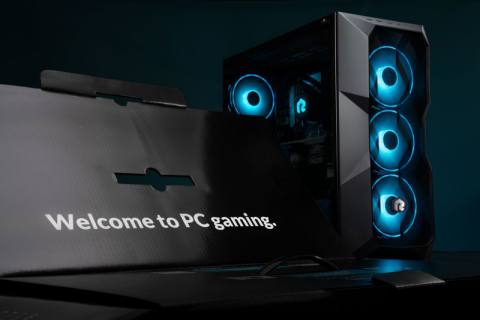
One of the allures of PC gaming is building your rig to the specs you need. Last year, while I didn’t pick my components, I built a machine using NZXT’s streaming PC package, which comes with all the parts you need and a handy guide to walk you through the steps. The build took us about three hours, with only a few hiccups along the way.
If you don’t want to dedicate time to the build and would rather have someone else put it together, there are plenty of pre-built PC options on the market. One of the newest companies exploring this space is Build Redux, a sister company of Digital Storm, the longtime boutique PC manufacturer.
When you go to Build Redux’s website, you see the option to build your PC, but not in the way you would expect. You pick your top three games from a preset list of fifteen titles. The options include many reflex-based shooters like Call of Duty Warzone, Overwatch, and Apex Legends. When you click a game, a framerate appears over the box art. Clicking Apex Legends reveals a reading of 70 frames per second for Build Redux’s “good” PC model. The “better” model raised the framerate to 110, and “best” jacked it to 145.
The difference in price at this point is good at $1,415, better at $1,879, and best at $2,259. After selecting the option you want to explore, a screen shows all the components in your tower. In my “best” option, I see I’m getting an NVIDIA GeForce RTX 3080 10GB graphics card. That’s a nice card, but I could upgrade it to something better like the 3090 Ti 24 GB, but it would raise my cost by $888. You can tweak most options, from the memory and cooler to storage and power supply.
Once my build is complete, I see a $99 build fee. Additionally, I learn all machines come with a two-year parts and labor warranty to replace or repair any malfunctioning hardware, just as long as it wasn’t physically damaged.

Build Redux sent me a default “best” model for review. The cardboard shipping container is sizable, consisting of thick padding for the formidable foot-and-a-half tall tower. At the top of the box sits a long black container reading “Welcome to PC gaming.” Inside, I first see a quick-start guide that consists of just a handful of steps, such as removing padding inside the tower, ensuring the cables look good, and learning where to plug in the peripherals.
After just a minute or two, I boot the machine to a symphony of color. Rainbow hues spin and rotate brightly from three circular LED lights on the machine’s face. Turning the unit slightly to my right, a glow emits from another light behind a glass panel, giving me a good view of the hardware on display. It’s a beautiful sight, and I can freely change what colors I see and how intense they are using a small remote in the box.
Seconds later, I see the machine’s desktop, and moments later, I’m downloading Steam, followed by several games I want to use to check out the hardware’s capabilities. The only sound I hear at this point is the clanking of my keyboard; the machine is ghostly quiet when doing basic web surfing and app interactions. Build Redux delivers a pug-and-play experience right out of the box that is just as easy to set up as a console.
Here are the review units specs:
CPU: Intel Core i7 – 12700K – 12 Core
GPU: NVIDIA GeForce RTX 3080 Ti Founder’s Edition
Memory: Patriot Viper Elite II 16GB 3200mhz BULK (32BG Kit 2x16GB)
SSD: Kingston NV1 NVMe M.2
Cooling: Cooler Master CN REDUX 240mm
Motherboard: ASUS Prime Z690-P WIFI D4
PSU: HighPower HP1-H 850W Gold Fully Modular
Case: Redux TD500
When asked what people can expect from the specific hardware, a Build Redux representative tells me that my configuration is a bit old and has now been updated slightly with different tech, but assures me it is in the same ballpark as what people can get today. The company doesn’t post the brands for each component, as they often change based on supply. This latter point is a bit concerning, as the consumer should know what’s in there. There’s a bit of blind faith, but Build Redux is ensuring compatibility.
The first game I test is Elden Ring, as I have recently seen it roaring on another high-end machine with maxed-out settings. The RTX 3080 handles it easily, delivering a silky smooth framerate at 2560×1440 resolution and all settings at the highest levels. The only change is a slight elevation in fan noise. The fan is quiet but noticeable from beneath my desk, just a few feet from me. I also checked out Stray with an uncapped framerate, and it looks fantastic.
I then spend time with some of this generation’s more graphically demanding titles. Cyberpunk 2077 ran without a hitch on the ultra ray tracing setting, with all other fields set to the highest levels. Horizon Zero Dawn also looked incredible with maxed-out settings. This machine has the horsepower to bring out the best in the current generation of games and should be fairly future-proof for the next few years of new releases.
The high-end model is a bit spendy yet delivers in performance and external beauty. It looks like a machine someone would custom build and should be great for streaming purposes, given its customizable lighting. Build Redux’s best foot forward impresses and is a great starter unit for people getting into PC gaming that roars with power at a reasonable price.
